Old and New
Observant readers may have noticed that the railings atop the parapet walls are cumbersome and seemingly out of proportion, given the miniature space hereabouts. However, from the garden below looking up they are clearly in scale and anything daintier or more delicate would be rather absurd since the building as a whole is 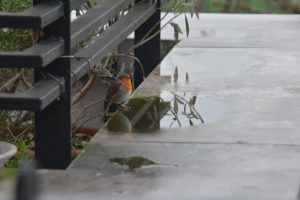 substantial. Nevertheless, a lot of effort on my part is spent trying to soften the impact, particularly in parts of the terrace directly in my eyeline. Mid-winter is challenging as the Clematis montana has shrunk to nothing and my eye is drawn downwards to the assembled pots and waterlogged plants. The pot feet have been no answer to the recent rainfall.
substantial. Nevertheless, a lot of effort on my part is spent trying to soften the impact, particularly in parts of the terrace directly in my eyeline. Mid-winter is challenging as the Clematis montana has shrunk to nothing and my eye is drawn downwards to the assembled pots and waterlogged plants. The pot feet have been no answer to the recent rainfall.
Viewed from the last few days of the old year there was a sense of some plants lingering, defiantly flowering: rose buds, salvias and agapanthus (or are they cape garlic?) generously struggling on, but with their glory days behind them. A few days later and in truth not so very much had changed on the balcony but everything has – the emergence of early Spring bulbs, a few buds and hellebores in season, already suggesting what is to come – longer days and the chance to enjoy the hands-on-ness of gardening.
Following a family bereavement a year ago some old family photos have reached me, many of which I remember from other albums and collections, but some are new to me. Amongst them are photos of a much younger me in gardening mode. I recognise the rose bed that I seem to be about to step into, but not the moment, although shoes and flower beds have been something of a recurring theme throughout my gardening life. I 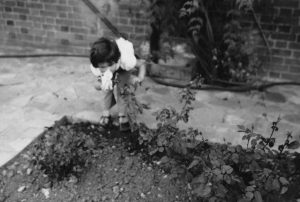 notice my shoes are rather shiny and it could be that I was rather proud of them, but the toes were definitely tipping towards the flowerbed, eager as I was to smell the impressively sized bloom. I can’t be sure, but the rose could have been ‘Peace’ . It was the era, and it was beautiful, and grew well in many of the gardens I frequented as a child.
notice my shoes are rather shiny and it could be that I was rather proud of them, but the toes were definitely tipping towards the flowerbed, eager as I was to smell the impressively sized bloom. I can’t be sure, but the rose could have been ‘Peace’ . It was the era, and it was beautiful, and grew well in many of the gardens I frequented as a child.
Later, when an often rather exhausting mixture of work and other pressures encroached on leisure moments, I took to gardening again, but old habits (young habits) die hard and while waiting for the kettle to boil or supper to cook I would wander out of the back door, to the immense frustration of my closest family, and find myself again amidst a flower bed trying to tame a straggly passionflower or rescue a water starved honeysuckle. The distance was not the problem, as it was a very small city back garden, but the journey was often made in extravagantly expensive shoes, a luxury I am still trying to resist. As it happened, this hidden-away house was behind a larger riverside property owned by Nanette de Valois (Dame Nanette by then) who in her late years would walk down the lane dividing us, sometimes stopping to admire or comment as I rummaged in the front garden, while using her stick to point, very much as I imagine she must have done to correct ballerina’s points or positions. She had strong views on my planting too and was never given to faint praise.
I also recognise my earliest garden, as well as my sense of concentration and contemplation, with the hand-bag lending a suggestion of a Royal walk-about. Looking again, the carefully demarcated area, under apple trees, and with extremely unpromising stony soil, did have the benefit of being south facing and out of sight, so not required to fit into any planting design or overall scheme. I had a scheme of my own which may be a false memory but I think depended on even rows, strips of seeds, planted regularly and the hope of a rather well ordered and uniform display. 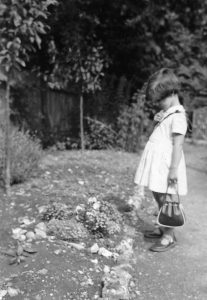 My expression in the black and white world of post-war photography suggests that this was an early experience of the uncertainty of gardening. I look rather perplexed and disappointed. Things don’t always go to plan, and in the fertile soil of horticultural ignorance serendipity can easily gain the upper hand. I have now learned about the locally familiar horticultural discoveries in the streets of Columbia. There, opportunistic orchids grab any crack in the paving, or crevice in a wall, to anchor themselves before flowering profusely, sustaining their glory, unchanging as the year moves on while the uniform, seasonless conditions prevail. Something to think about while waiting for the days to extend.
My expression in the black and white world of post-war photography suggests that this was an early experience of the uncertainty of gardening. I look rather perplexed and disappointed. Things don’t always go to plan, and in the fertile soil of horticultural ignorance serendipity can easily gain the upper hand. I have now learned about the locally familiar horticultural discoveries in the streets of Columbia. There, opportunistic orchids grab any crack in the paving, or crevice in a wall, to anchor themselves before flowering profusely, sustaining their glory, unchanging as the year moves on while the uniform, seasonless conditions prevail. Something to think about while waiting for the days to extend.
Lessons learned
So for the moment, while gardening is a virtual activity I have turned to reading and planning, and was heartened to read that the Royal Horticultural Society is now encouraging dense planting wherever possible, so for the benefit of plant-living invertebrates the advice is to ‘put in plenty of plants and let them grow vigorously’. And I think I may have found an answer to the challenge of increasing the number of containers in my very small space. Each container is already overcrowded, and protecting some space for socialising, or sitting is important too, but not necessarily compatible with more containers, particularly the large ones I am inclined to introduce. I also need to be able to reach the periphery of the balcony to tend, feed, water, plant, fuss, admire, deadhead and so on. I think pot movers may be the answer – and they could be tied to the now vacant table leg in the face of stormy weather. For the first time 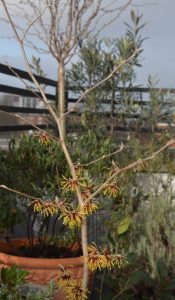 I have the luxury of a smooth tiled terrace so why not acquire some pot movers or trolleys, some new plants and some containers to occupy the pot stands which can then hold court in the middle of the terrace bringing some interesting planting opportunities – an underplanted witch hazel recently caught my eye and could introduce height and scent rather unexpectedly. The containers I hope, can then be moved back and forth as friends and flowers arrive and depart, although having convinced myself that this is a good idea I have yet to convince those around me.
I have the luxury of a smooth tiled terrace so why not acquire some pot movers or trolleys, some new plants and some containers to occupy the pot stands which can then hold court in the middle of the terrace bringing some interesting planting opportunities – an underplanted witch hazel recently caught my eye and could introduce height and scent rather unexpectedly. The containers I hope, can then be moved back and forth as friends and flowers arrive and depart, although having convinced myself that this is a good idea I have yet to convince those around me.
This all makes me think of other modes of garden transport; wheelbarrow rides heading to the compost heap (no sophisticated bin system then) or wheeling a carefully created Guy to its funeral pyre, my elderly father using the mower as a motorised walking frame (while still in charge of the upkeep of the grass), and a surprise encounter with a miniature railway when on a residential summer course in a rather grand residence. It was designed to bring drinks from the kitchen to the terrace although by then the track was in disrepair. These recollections are topped by the story, recently confirmed, of a family member, now a father himself, who was ingenious enough at the age of six or seven to take advantage of a Sunday colour supplement advertising ‘ride-on mowers’. Using his own initiative he arranged for a sales rep to come to the house to demonstrate the mower, which in itself was quite ambitious as the lawn was smaller than a tennis-court. It turned out that the salesman first needed to dismantle the machine in order to gain access to the back garden, all to the astonishment of his unprepared parents.
Meanwhile, I’m still under the sway of the plant filled extravaganza at Petersham Nurseries, where lunch in the large conservatory was a well choreographed delight, with elegant food garnished with flowers and the footwear necessarily mud resistant. So an ever more densely packed balcony could satisfy my aesthetic inclinations as well as the local wildlife. But I might need a wedge or two as well, since the terrace has an imperceptible, but significant slope to right and left, rising to a peak in the centre to ensure a run-off for the very present rain.
And there has been a lot of rain. Too much for one of my beautiful E Nicholii which has been battered by winter storms, including the once notorious Storm Eleanor. Although securely tied to a table leg it was damaged by my careless placement of a stake intended to help maintain its upright stance, which in itself was probably mistaken as its natural habit is to stoop as it grows. Abraded, wounded and waterlogged it has been returned to it’s pre-flood location where with protection from the elements it once thrived. Recovery may take some while. I exchanged it for the pittosporum, Pittosporum tenuifolium ‘Elizabeth’, which has had to relinquish its place and may not like the colder, more exposed new position, but hopefully will cope better with the rain. I may have had too much faith in staking by table leg but the pittosporum looks good (for the moment) and some space has now emerged on the table top alongside, waiting to be occupied in the days ahead.
Rain also played its part in the planned log gathering, as Boxing Day was grey, wet and dreary outside and the search was deferred. Another walk in the deer park will be rewarded by a wide range of insect accommodation, and probably a selection of minute creatures too. But presumably since any slightly rotten piece of wood will already be occupied I’m left wondering – what is more wild life friendly in the overall scheme of things: to broaden the habitat range by introducing insect life unfamiliar with living at height to a wind swept roof space, or leave well alone. Would an unrotten piece of wood left to get rain soaked on the balcony be best of all, although it might involve patience. Meanwhile blackbirds, I suspect, are ignoring my bird feeder, even though my chosen bird food has blackbirds in mind, preferring to dig amongst my pots in search of food on the hoof, or at least with six legs, while scattering clumps of compost around.
The weather and winter season expose my frailities, particularly my dislike of the cold and the wet, which was reinforced in my early student days which were spent traipsing through a sea of mud as the October rain was ceaseless and the hall of residence still marooned in a building site. My first purchase in the unfamiliar Northern landscape was a pair of wellingtons, which was a disappointing start for a child of the 60s.
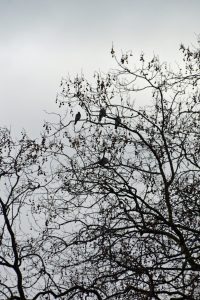 The frailities of my planting and planning, obscured by an abundance of greenery later in the year, are also very apparent now. It is true that on all sides, from indoors looking out, there are silvery evergreens, shapely pots, corkscrew willow supports, hellebores and other emerging signs of life including the sunseaking silver bush Convolvulus cneorum bizarrely coming into flower. But an unexpected moment on the balcony, taking a visiting friend on a very brief guided tour, illuminated the jobs that need doing and my reliance on the plants to obscure some weak underpinnings. Carefully, casually assorted pots can quickly become an ill-assorted collection of neglected plants, mismatched and straggly, waiting to be pruned, with marginal areas where wild-life friendliness might be a euphemism for idleness.
The frailities of my planting and planning, obscured by an abundance of greenery later in the year, are also very apparent now. It is true that on all sides, from indoors looking out, there are silvery evergreens, shapely pots, corkscrew willow supports, hellebores and other emerging signs of life including the sunseaking silver bush Convolvulus cneorum bizarrely coming into flower. But an unexpected moment on the balcony, taking a visiting friend on a very brief guided tour, illuminated the jobs that need doing and my reliance on the plants to obscure some weak underpinnings. Carefully, casually assorted pots can quickly become an ill-assorted collection of neglected plants, mismatched and straggly, waiting to be pruned, with marginal areas where wild-life friendliness might be a euphemism for idleness.
Ideas for the future
However, I am getting better at plant selection and ensuring there is something of interest as time goes by, although there have been some expensive mistakes along the way. Am I about to make another I wonder? In a favourite catalogue of plants that I am very unlikely to buy (as I don’t need to worry about rabbit or deer resistant species which are often highlighted in the small print of this particular publication) I have spotted a wisteria, Wisteria Frutescens Amethyst Falls to be precise, which could be the answer to everything, as it has highly fragrant purple and lilac panicles, the habit stays compact when grown in a pot and it flowers the first year. I also thought that it didn’t need any pruning or training, but on re-reading that is clearly wishful thinking. So if my ailing E Nicholii succumbs, or even if it doesn’t, it could be a plant to acquire.
A book by the appropriately named Paul Wood, London’s Street Trees, A Field Guide to the Urban Forest, is also becoming a firm favourite although I have had to overcome my initial disappointment that my particular wooded corner at the city edge doesn’t get a mention. I have already learned a great deal about the history and current influences on the diverse tree planting in the capital, and that surprisingly only 3% of the total tree population are London Planes. These are beautiful and tolerant of pollution so doubly blessed, even though they make me cough and my eyes water and are apparently no good for wild-life. This news comes at a tricky time as the horse-chestnuts below are struggling and may be nearing the end of their lifespan. Planting a London plane has been suggested as a way of managing the succession, and I do have some say in the decision, but I am now in a dilemma as I had assumed that a vote for a plane would also be a vote for wild-life.
Memos to self
A Christmas gift to a young Australian couple, might have been more welcome if I’d explained that the ‘plants’ were hyacinth bulbs and in time would inevitably need staking as they began to keel over. I didn’t. The containers which are now beginning to show signs of re-birth are mostly crammed with unidentified plants. I’ve kept all the labels (in a drawer) and intended to draw plans. I didn’t. Hopefully as they emerge their identity will become more obvious, but not much help now. And I thought Nandina Domestica was a bamboo. It isn’t.
More encouragingly my brand new Cherry Pigmy Kordia, promising blossom and fruit in time, already seems happily established in its new home. My olive trees are thriving in spite of, or because of, my anxiety inducing pruning of a few months ago and I’ve ordered a new lady-bird home.
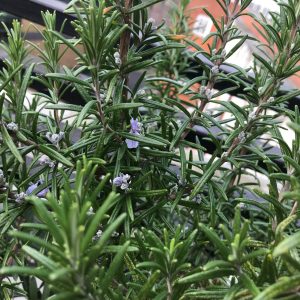
Meanwhile although a raw chill and grey skies have recently taken hold, my standard rosemary is producing more and more flowers, presumably in anticipation of the arrival of particularly early bumble bees. While the admittedly small number of fruits that grow on my olive trees could I learn, at least theoretically, join with others to produce a locally sourced crop for the expanding craft food industry.

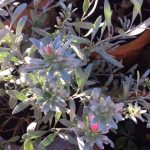

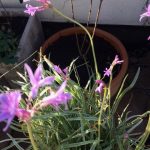
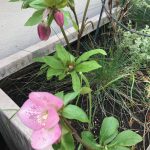



Spring is announced by our first Camelia in full bloom. Perhaps you might squeeze a pot Camelia into a corner of your terraee and enjoy that early indicator that Spring will actually come to us and Winter is only a limited season. You can dispose of it when it gets too big but enjoy it while you can.
Pretty sure it’s Ninette
I’m sure you are inundated with plant suggestions but have a look at Coronilla valentina subsp. glauca ‘citrina’ I bought one as a house plant a couple of years ago as I was told it would do well in a north facing porch. But it didn’t flower and got covered in greenfly last summer so was left on the terrace on it’s way to the compost heap. It suddenly started flowering last October and has been doing so ever since in spite of Yorkshire wind, rain and snow. I took a photo but can’t load it on to this comment. I’ll send it in an email.
Gord’s bees have been out in the weak January sunshine, so London bumbles should soon be on your Rosemary.
Have you thought of hanging things out over the edge? As well as extending the garden, it might also hide the railings…
Love J
Thank you all for your comments – and yes, a gift of a beautiful Camelia was initially a great joy, and in turn it enjoyed the prize (sheltered) location it was given, but quickly became much too big. Pruning wasn’t the answer as I probably pruned it at the wrong season (summer for shape, winter for growth, or is it the other way round?) and it got out of hand and very sadly had to go.
And I’m anxious that if I can’t spell Ninette correctly (my apologies) Coronilla valentina subsp. glauca ‘citrina’ might be rather challenging. I’m also a bit worried that although it has taken to Northern winters, on the whole, I have been cowardly, or perhaps sensible, and planted house-hold names that might cope with the conditions and my horticultural limitations. On the other hand it sounds extremely tempting, I could expand my gardening knowledge, pay more attention to spelling, and an internet search wouldn’t take long – and I could also add to my selection of trailing plants too which are the obvious way to distract the eye from the railings.
I have had great success with Trachelospermum jasminodes, a London favourite, as well as summer flowering clematis, although they do get blown about, but the winter flowering varieties got so rampant that keeping them attached to the railings was in itself problematic. However, I’m beginning to think that I should try again and look carefully for varieties that are appropriate. But even honeysuckles suggested for container growing haven’t really thrived, and mindful of the law as it relates to property, and the knowledge that the railings are included in the ‘common parts’, I have to be a bit cautious about how I attach things. Soft Flexi-tie is find but beyond that I’m not sure.
I’m hopeless with plant names. I copied that one off the label. Like you I keep the labels but mine are jumbled up in a small bag in the cellar. I had to find it recently after a neighbour asked what it was.